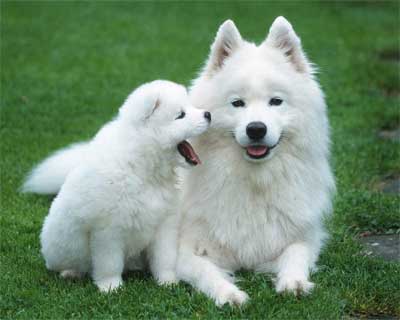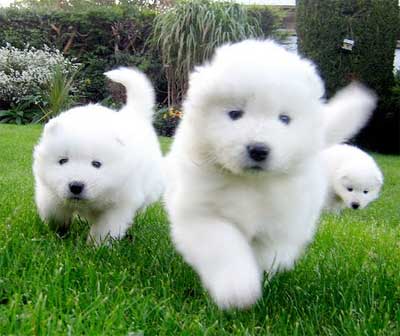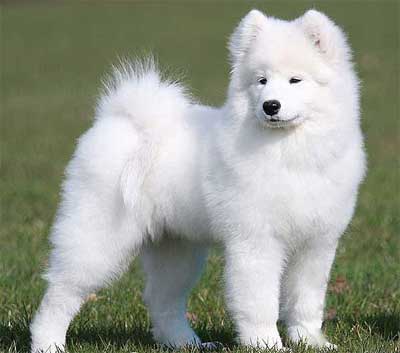
SamoyedSamoyedDescription :The Samoyed has a compact muscular body. The wedge-shaped head is broad and slightly crowned. The muzzle is in proportion to the size of the dog, tapering to the nose. The stop is well defined but not abrupt. The nose color can be black, brown, or liver. The lips are black. The teeth meet in a scissors bite. The dark almond shaped eyes are deep-set, somewhat wide apart, with a slanting lower lid and dark rims. The erect, triangular ears are slightly rounded at the tips. The tail is moderately long well covered with hair, carried rolled on the back. The legs are solid and muscular and the feet are flat and covered with hair. The thick, double coat is profuse. The undercoat is soft, short, thick with longer hairs growing out to the outer coat. The outer coat is harsh, and stands straight out, not wavy. Males are more profuse than females. There is a ruff around the neck and shoulders, framing the head. Coat colors include, pure white, biscuit, yellow and cream. Sometimes white with silver-tips. Pure white is preferred in the show ring.
Temperament :Samoyeds are gentle dogs. Very devoted, easy-going, friendly and quite playful, they love everyone. They will gladly be friendly to all, including intruders. They are too friendly to be of much use as a watchdog, although its bark will alert you to the presence of strangers. It willingly adapts to family life and gets along well with children. They are highly intelligent, and will respond to firm, patient training, which should be started at an early age. Make sure you are this dogs firm, confident, consistent pack leader to avoid potential behavior issues such as, but not limited to, obsessive barking. The Sammy is accustomed to working in teams, and shows outstanding qualities. When this dog is given what he needs to be a stable minded dog, i.e. enough mental and physical exercise, along with clear leadership, it proves itself to be outstanding, good-natured, lively, and sociable. It never seeks trouble but can handle an adversary if necessary. They have a reputation of being chewers. If the Sammy is lacking in leadership and or exercise they become very destructive if left alone for many hours at a stretch. Samoyed's can get along with non-canine pets when raised with them from puppyhood or when properly trained to do so, however they do have an instinct to hunt and caution should be taken around other small animals. They can get along with a family cat. This breed has an instinct to herd.
Height, Weight :Height: Dogs 21-23½ inches (53-60 cm.) Females 19-21 inches (48-53 cm.)
Weight: Dogs 45-65 pounds (20½-30 kg.) Females 35-50 pounds (16-20½ kg.)
Health Problems :Samoyed are particularly prone to hip dysplasia and some suffer from diabetes. Also prone to skin allergies. They are prone to PRA (eyes) primarily in male dogs.
Living Conditions :The Samoyed will do okay in an apartment if it is sufficiently exercised. It is very active indoors and a small yard is sufficient. Their heavy coat makes these dogs unsuited to life in very hot climates.
Exercise :Needs a reasonable amount of exercise, including a daily walk or jog. Take it easy during warm weather because the woolly undercoat inhibits loss of the heat built up during exercise.
Life Expectancy :About 12-15 years.
Grooming :Extensive grooming is needed. They are seasonally heavy shedders. The fluffy double coat needs frequent brushing, but tends to stay white without bathing. Some people with allergies have reported that the coat of the Samoyed did not bother them.
Origin :Samoyeds are an ancient working breed. They have lived in Siberia with hunters and fishermen known as Samoyeds, hence where the breed received it's name. The Samoyed people used the dogs to pull their sleds, guard their property and for herding reindeer. Their gene pool is closely related to the primitive dog with no wolf or fox mixed in. The dogs slept with the people to keep them warm. Robert Scott, an explorer brought the dogs to England in 1889. It was in England that the breed was further developed and from there they spread throughout the rest of the world. They were recognized by the AKC in 1906.
Group :Northern, AKC Working




